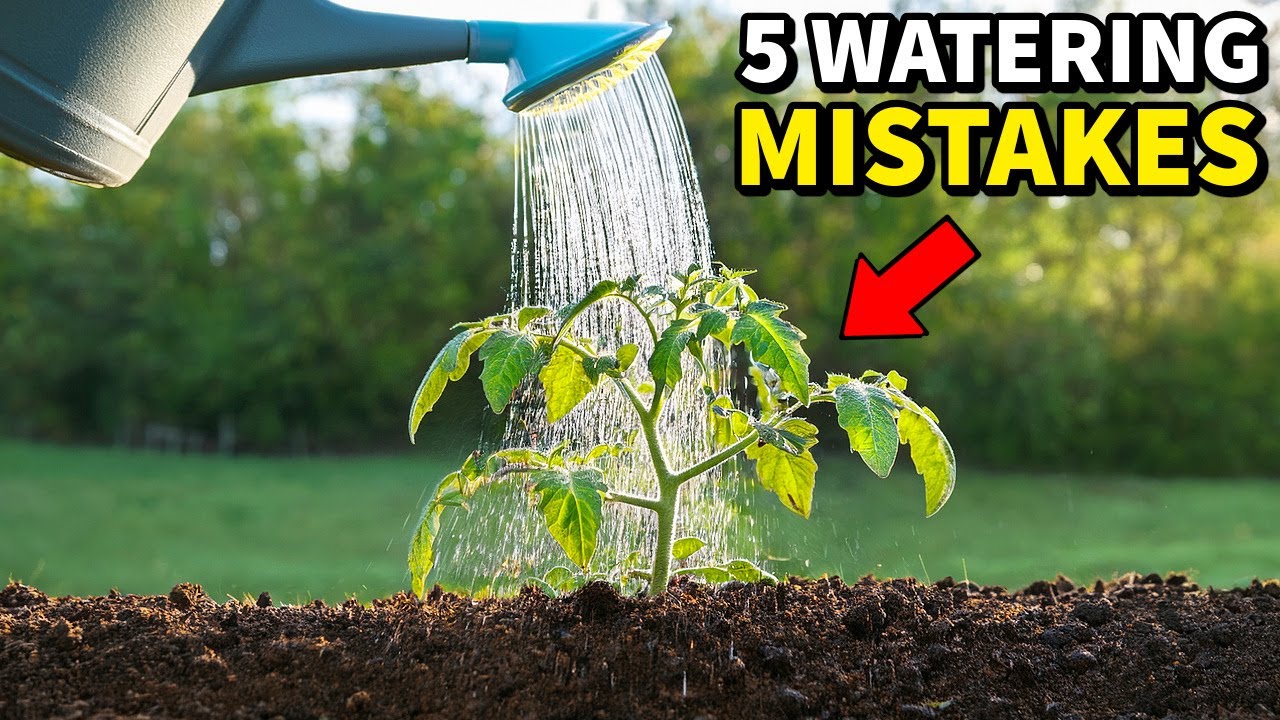Are you confident that your watering habits are helping your garden thrive, or could they be doing more harm than good? In this post, you’ll discover the five most common watering mistakes most gardeners make—and how you can avoid them to keep your plants healthy, lush, and vibrant.
Introduction
There’s a strange kind of intimacy that develops between a gardener and their plants. It’s the slow build of hope, frustration, and the hopeful belief that you’ve finally cracked the code of Mother Nature’s temperamental mood swings. And if there’s one facet of gardening that quickly turns into a comedy of errors, it’s watering—sometimes the humbling art of giving your garden just enough moisture to thrive, without drowning it in your well-meaning ignorance.
In Southeastern North Carolina’s Zone 8B—where the climate offers warm summers and gentle winters—watering becomes both an art and a science. But, oh, how easy it is to fall into traps that can undo your best intentions. The wrong watering practices can become silent saboteurs, spreading diseases, wasting resources, and turning what should be a lush paradise into a soggy, sad mess. So, let’s explore the five common garden watering mistakes you should never make—armed with wit, wisdom, and just enough garden lore to keep your green thumb intact.
Overwatering: The Silent Killer of Garden Joy
Imagine pouring gallons of water onto your precious petunias, thinking more is better, only to watch their leaves turn yellow and their roots drown in a muddy abyss. Overwatering is like that well-meaning friend who never picks a good time—always showing up with more than you asked for, and staying way too long. In gardening, overwatering doesn’t just waste water; it invites a host of problems that can undo those weeks of tender nurturing.
Too much water suffocates roots, depriving them of oxygen and creating the perfect environment for root rot and fungal diseases. What’s more, waterlogged soil can become a breeding ground for nasty pathogens that spread rapidly among your plants, turning your lush garden into a fungal horror show. This mistake is especially tempting in Southeastern NC, where the warm climate can trick gardeners into thinking their plants are thirsty when, in fact, they’re drowning. The key is to learn the right watering schedule—think of it as a gentle, consistent embrace rather than a deluge.
To avoid overwatering, you can perform simple soil tests—stick a finger or a moisture meter into the soil and see if it feels damp or dry at the root zone. Mulching your garden also works wonders, acting as a buffer by retaining moisture during hot spells and preventing unnecessary watering. Remember, patience is a virtue in gardening; letting the soil dry out slightly between watering sessions prevents most overwatering mishaps. Your plants, like good friends, prefer a balanced relationship—nurture with care, not excess.
Watering at the Wrong Time (And Why It Matters)
Timing is everything—especially when watering your garden. Watering at the wrong time can turn a simple task into a major faux pas, inviting pests and diseases to the party. Early mornings are usually the best window because they allow excess moisture to evaporate during the day, reducing the risk of fungal infections. Watering in the evening, on the other hand, can leave your plants damp through the coolest part of the day, creating a lovely banquet for mold and mildew.
In Southeastern North Carolina’s Zone 8B, the climate’s warm mornings beckon for a gentle start—imagine sipping your coffee while the dew-laden leaves bask in the first light. Avoid midday watering when the sun beats down fiercely, causing water to evaporate rapidly and leaving your efforts largely wasted. Plus, watering during the heat of the day can scorch plant leaves, especially if you’re using overhead sprinklers that cast water droplets like tiny magnifying glasses.
There’s also the underrated importance of seasonal timing. During hot, dry spells, plants need consistent moisture, but don’t be tempted to give in to the urge to douse everything all at once. Instead, establish a watering routine that fits your garden’s rhythm—whether it’s early morning or a gentle evening soak. It’s about working with the natural climate instead of fighting it, helping your plants stay happy, hydrated, and disease-free.
Ignoring Soil Moisture Needs and Conducting Soil Tests
You wouldn’t try a new recipe without tasting it first, so why would you water your plants without understanding their soil’s moisture needs? Many a gardener has guessed wrong, pouring water onto soil that’s already wet or, conversely, neglecting droughty patches until their plants look as if they’ve seen better days. Conducting soil tests is the secret weapon—an honest assessment of what your garden really needs beneath the leafy surface.
The beauty of soil testing is that it takes the guesswork out of watering. Using simple, affordable tools—either a digital moisture meter or a basic DIY pinch test—you can gauge whether your soil is parched, damp, or swimming. This practice is especially vital in Southeastern NC, where sandy soils can drain quickly, demanding more frequent watering, while clay soils tend to retain moisture longer. By understanding your soil’s unique characteristics, you can tailor your watering schedule to match its needs, saving time, money, and countless headaches.
Moreover, soil tests can influence more than just watering—they inform your fertilization and mulching strategies, creating a holistic approach to plant health. Armed with that knowledge, you’ll stop over- or under-watering in their tracks, ensuring your plants are thriving in harmony with their environment. After all, the garden is as much a science as it is an art—better to read the soil’s story than to guess at half of it.
Inefficient Watering Methods: Drip Systems and Overhead Sprays
There’s a reason professional landscapers swear by drip irrigation—because it’s the gardening equivalent of that perfectly timed, well-placed coffee order. The difference between a thriving vegetable patch and a soggy, disease-ridden mess can hinge on the watering method you choose. Using the right tools—like drip system components—can make all the difference in conserving water and promoting healthier plants.
Overhead watering, with its spray nozzles and garden hoses flailing about like a garden party gone wild, might seem convenient—until you realize it’s also the perfect delivery system for fungal spores and bacterial boogeymen. Plus, a gust of wind can turn your delicate sprinkles into a global deluge, wasting precious resources and creating unnecessary run-off. Instead, installing drip irrigation or pointing soaker hoses directly at the root zone ensures water is delivered where it’s needed most, with minimal waste.
Switching to efficient watering systems doesn’t mean sacrificing the lush look of your garden—it’s about being smarter, not lazier. These systems are especially great in your neck of the woods, where water conservation is key to both environmental sustainability and your wallet. Remember, the goal isn’t just to hydrate but to foster resilient, disease-resistant plants that stand tall amid the humid, warm climate.
Frequently Asked Questions
How can I tell if I’m overwatering or underwatering my plants?
Recognizing the signs is half the battle. Overwatered plants often exhibit yellowing leaves, wilting despite wet soil, and a sour smell emanating from the roots. Underwatered plants, conversely, show dry, wilted leaves with soil that feels crumbly and parched. Using a moisture meter or corralling your thumb into the soil to assess moisture can help clarify their needs. The key is consistency—learn your plants’ cues and stick to a schedule that respects their natural preferences.
What is the best time of day to water my garden in Zone 8B?
Early mornings are the golden hour for watering—when the air is cool, and dew still clings to the leaves. This timing allows plants to soak up moisture with minimal evaporation, setting them up for a day of growth. Evening watering might seem tempting but can leave your garden damp overnight, inviting fungi and diseases. Starting the day with well-timed watering keeps plants happy and healthy in Southeastern NC’s warm climate.
How does mulching help retain moisture and prevent disease?
Mulching acts as a protective blanket—moderating soil temperature, conserving moisture, and preventing weeds from devouring resources. Organic mulches like straw, bark, or composted leaves also improve soil health, fostering beneficial microbial activity. By preventing soil splashes during watering and rains, mulching reduces the risk of soil-borne diseases creeping onto your plants, making it an indispensable gardening hack.
Are there any organic gardening practices I should incorporate?
Absolutely. Organic gardening emphasizes sustainable, chemical-free methods—composting, organic fertilizers, and companion planting are all mainstays. Using organic drip emitters, selecting disease-resistant heirloom varieties, and incorporating beneficial insects create a resilient ecosystem. The goal is to nurture your garden naturally, respecting the environment and encouraging biodiversity, which ultimately champions the long-term health of your plants.
Can I use DIY hacks to improve my watering routine?
Definitely. A simple DIY watering system, such as repurposing plastic bottles with tiny holes or creating a makeshift rain barrel, can serve as eco-friendly solutions. Pairing these hacks with smart planning—like installing timers or using local weather data—can save time and water. These little innovations foster a sense of pride and self-sufficiency while giving your plants the gentle, consistent hydration they crave.
Final Thoughts
Watering your garden correctly isn’t just about quenching the thirst of your plants; it’s about cultivating a mindful relationship with nature, one drop at a time. The pitfalls of overwatering, poorly timed watering, and inefficient methods threaten the vitality of your hard-earned green space—yet armed with knowledge and a sprinkle of patience, you can steer clear of these garden faux pas. Think of your garden as a living, breathing symphony—each note played with precision and care produces the most beautiful harmony.
Remember, every garden has its quirks; here in Southeastern NC, with its warm embrace and occasional humid humidity, tailoring your watering routine to seasonal changes is part art, part science, and entirely satisfying. By conducting soil tests, embracing drip irrigation, and avoiding the classic mistakes, you’ll transform your garden into the lush haven you envision—blooming, thriving, and beautifully yours. Cheers to many happy, well-hydrated gardening days ahead.

